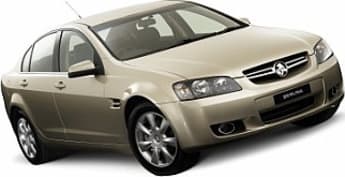The orange V8 seemed to fuse with the dusty red ochre of the country dirt road. Up ahead, a stray cow plodded along the centre of the thoroughfare, all angular haunches and indignantly upswept tail, completely blocking the narrow road.
One drop of a clutch, and this bovine stop sign would have been left in the dust. But for once, the motor-writing fraternity was showing some restraint. Not an ounce of fuel could be wasted.
The Holden Economy Drive has become an annual pilgrimage from Sydney's CBD to the heart of the Gold Coast — arriving just in time for the Indy 300 race weekend.

From Sydney peak-hour traffic, through suburbia and back-of-nowhere dirt roads and over the sunny Queensland border, this 1200-or-so-kilometre journey is a competition to find the lightest foot in the business.
And to separate fact from fallacy when it comes to real-world fuel economy.
The new VE Commodore's slight increase in consumption over the previous VZ model fuelled much debate at the recent launch. This was a chance to test models ranging from a dual-fuel V6 to HSV V8s in normal road conditions.
A minimum time and average fuel consumption figure worked as a guide for each car assigned during the two-day journey. But the objective fuel figures seemed wildly optimistic at first.
Could a V8 VE Commodore — with an "official" figure of more than 14 litres per 100km — cover 100km in an hour using less than 10 litres?
We started from Sydney with a VE SV6, which could almost have been mistaken for a V8. An options pack of old-school stripe pack and hexagonal-pattern Holden 19-inch alloys could be blamed for the confusion, making the V6 sports model look almost as imposing as its eight-pot SS sibling.
The SV6 looked and even sounded the goods, with a high-pitched burble emanating from its pipes on the odd occasion when the go-pedal was a given a meaningful prod — although that was a rare occurrence on this trip.
A combination of city, highway and some suburban and country roads in the SV6 returned a fuel figure of just 7.7 litres per 100km, at an average speed of approximately 75km/h.
Looking ahead for traffic, cutting out unnecessary braking or acceleration, and cruising the highway at 1700rpm produced an even better result in the big V8s.
The top-spec SS V achieved just 8.6 litres per 100km with a similar average speed, thanks to a feathered throttle, a wise choice of ratios on the six-speed manual, and a bit of luck with traffic and traffic lights.
The WM Caprice wasn't so lucky with traffic, averaging 10.4 per 100, but at a slightly higher average speed.
The big daddy of performance V8s from the Holden Special Vehicles stable couldn't match the SS V or the Caprice for fuel consumption.
It was loud in every aspect, from its big V8 powerplant to its gnarled, aggressively angular body kit, and driving for economy was marred by a constant craving to sample some of the new GTS's 307kW potential.
Average speed was again closer to the 75km/h mark, with overall consumption coming in at a 10.5 per 100.
But the prize for fuel economy was never going to sit in an HSV trophy cabinet. That went to the dual-fuel VE Commodore.
Factory-fitted dual fuel is available on Omega and Berlina V6 models as well as the VZ Executive, Acclaim and Ute range. It costs an additional $1900 after the $2000 government LPG rebate.
Holden's 3.6-litre V6 has been factory adapted to run both LPG and unleaded petrol, with the engine mimicking the petrol response while using the efficient gas alternative.
Power and torque figures stand at 175kW and 325Nm (10kW and 5Nm less than the petrol-only model), and fuel economy is 16 litres per 100km on LPG, and 11.7 per 100 on petrol.
This enables more than 1100km of travel before needing to refuel both 73-litre tanks. A full tank of LPG would be good for about 450km, yet cost about $38 to fill — less than half the cost of the standard petrol tank.
Disadvantages are a 100kg heavier kerb weight and reduced boot space, but the pros are clear. No amount of lightfoot feathering in any other Holden would save so much at the bowser.
Yet the economy brought back by both V6 and V8 engines (all the cars carried three people, plus a week's worth of luggage and camera gear) was fairly significant.
One thing that ADR fuel figures cannot tell the consumer is what a car like this can achieve on the open road.
The ADR numbers are a combined highway and city figure, and the published figure of 11 litres per 100km for an SV6 or 14.4 for an SS may be a good indication of what to expect.
But use these cars predominantly for highway driving, or simply drive with an eye to economy, and you could find less leakage from your wallet.
Sipping slowly
Driving for economy isn't rocket science. There are several simple (and safety-oriented) measures you can take to reduce fuel consumption and leave your wallet closer to full.
Look Ahead:
Drive with your head up, and eyes constantly looking for the traffic ahead. Not only is this safer, it reduces thirsty stop-go acceleration. Anticipate, and back off the gas.
Use The Gears:
Automatics are becoming lighter and more efficient, but typically they use more fuel than manuals. When driving for economy, stay within the engine's torque band; don't over-rev into peaky, thirsty power.
With an automatic, ease up on the throttle between shifts. As the engine revs high and prepares the change up, a slight lift of the throttle maintains power without wasting fuel as the transmission engages the next gear. This also makes smoother shifts.
Driver Aids:
A sport or power button typically heightens engine, gearbox and throttle response. The gears of an automatic will change later to allow higher revs, and the engine becomes more accelerative and eager.
Some programs even cut out top gear altogether. So, where possible, particularly on highway stints, use an economy setting.
Cruise control and speed limiters also help a wandering right foot and improve economy.
Speed:
You go fast, you use more fuel. Enough said.
Service:
Regular maintenance will ensure all cylinders are firing efficiently. This is particularly true of diesels, which can claim brilliant fuel economy until the black exhaust reveals the tell-tale signs of unburnt fuel and neglect.
Tyres:
Correct tyre pressures will improve fuel economy. Check the tyre plate on your vehicle (usually located on the inside door panel) for the manufacturer's settings, and check the pressures when you refuel to prevent this rolling resistance — particularly if yours is a heavy or load-carrying vehicle. Saves tyre wear, too.
Lighten The Load:
It's amazing how a full boot weighs heavily on the fuel bill; remove unnecessary objects. And roof carriers create wind resistance.
Holden Commodore 2006: Omega
| Engine Type | V6, 3.6L |
|---|---|
| Fuel Type | Unleaded Petrol |
| Fuel Efficiency | 11.0L/100km (combined) |
| Seating | 5 |
| Price From | $3,410 - $5,280 |
Pricing Guides
























.png)




.jpg)
